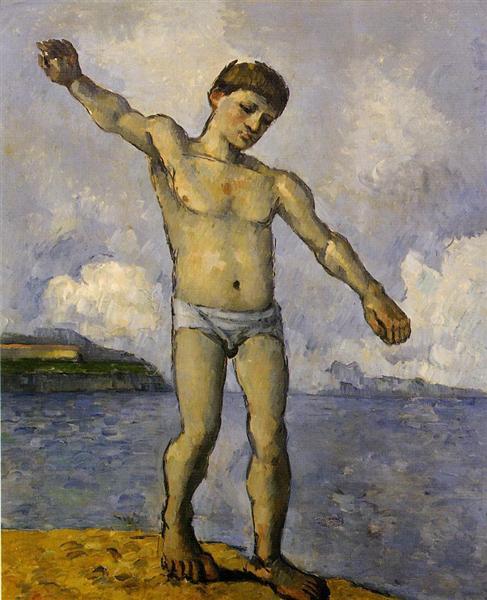Description
The work "Bañista with extended arms" (1878) by Paul Cézanne is a fascinating manifestation of his interest and experimentation with the human figure within a natural landscape. Cézanne, one of the precursors of modern art, broke with the academic conventions of representation by adopting a more structural and analytical approach. In this painting, a naked female figure is presented, erect with the arms extended to the sides. This gesture, which evokes an intimate relationship with both the surrounding space and the viewer, invites you to reflect on the connection between the human body and the surrounding nature.
The figure is in an environment that offers a strong contrast to nudity. With its pale skin, it shines against the earthly and greenish tones of the landscape. Cézanne is known for its particularly rich palette, which in this work uses dark, ocher and blue green, creating a visual balance that gives a sense of depth and movement to the painting. The understanding of color in this work is key to understanding the emphasis that Cézanne put in the structural aspects of color and shape, using tones that not only describe the object, but also build a coherent pictorial space.
The composition of the work is distinguished by the way Cézanne uses contours and textures. The lines that define the figure are irregular and are built by a series of brushstrokes that eradicate the illusion of a perfect photographic realism. This approach suggests a construction of the object rather than a representation of reality. The figure is not simply a body in a natural context, but a form that interacts with its surroundings, which reveals Cézanne's obsession with volumetric construction and the perception of space.
The context of the work is also interesting. During the time she was painted, Cézanne began to consolidate her style and distance of the influences of impressionism, although in her early career she was attracted to her principles. "Bañista with extended arms" is a clear example of the transition towards its characteristic style, in which the shape is essential and the color becomes a means to explore structure and spatiality.
The figure in painting, which does not have a clearly defined identity beyond its representation as a swimmer, reflects Cézanne's desire to investigate the human figure without the ornaments and narratives that often accompany it. The almost sculptural character of the figure gathered with a flat perspective and a detailed background highlights Cézanne's desire to find the balance between the volume and two -dimensional space of the canvas.
In the exegesis of the work, parallels can be drawn with other works by contemporary artists, both within the impressionist circle and in emerging currents of that time. The study of the nude in art has been a tradition, and Cézanne distances itself from typical idealization in favor of a more honest representation of human form. "Bañista with extended arms" can be compared with works by artists such as Edgar Degas, who similarly explored the human body in everyday contexts, although from a different perspective.
Finally, it is important to note that this work has been the subject of various interpretations over the years, being able to be seen not only as a study of the figure and the landscape, but also as a dialogue between the individual and his environment, which reflects The broader existential concerns of humanity. In his search for the essence of form, coloration and structure, Cézanne not only left an indelible mark on art history, but also opened paths that would later explore movements such as Cubism and Fauvism. The "bathtub with extended arms" remains a powerful testimony of artistic ingenuity and innovation of its time.
KUADROS ©, a famous paint on your wall.
Hand-made oil painting reproductions, with the quality of professional artists and the distinctive seal of KUADROS ©.
Reproduction service paintings With a guarantee of satisfaction. If you are not completely satisfied with the replica of your painting, we refund your money 100%.

